|
|
 |
|
Calanoida ( Order ) |
|
|
|
Clausocalanoidea ( Superfamily ) |
|
|
|
Clausocalanidae ( Family ) |
|
|
|
Clausocalanus ( Genus ) |
|
|
| |
Clausocalanus parapergens Frost & Fleminger, 1968 (F,M) | |
| | | | | | | Syn.: | Clausocalanus arcuicornis : Esterly, 1905 (p.142, figs.M); 1924 (p.89, figs.F,M);
C. pergens : Tanaka, 1960 (part., p.34, Pl.XII, fig.6) data from Frost & Fleminger;
C. pergens sp.1 : Fleminger, 1964 a (p.137);
C. arcuicornis minor Unterüberbacher, 1964 (part., p.19, Pl.27) | | | | Ref.: | | | Frost & Fleminger, 1968 (p.72, figs.F,M, Rem.); Chen & Zhang, 1974 (p.103); Williams & Wallace, 1975 (p.177, fig.F); Dawson & Knatz, 1980 (p.7,8, figs.F,M) ; Björnberg & al., 1981 (p.629, figs.F,M); Gardner & Szabo, 1982 (p.184, figs.F,M); Bradford-Grieve, 1994 (p.120, figs.F,M, fig.101); Chihara & Murano, 1997 (p.777, Pl.91,93: F,M); Lapernat, 1999 (p.13, 55, fig.F); Bradford-Grieve & al., 1999 (p.878, 916, figs.F,M); Bucklin & al., 2003 (p.335, tab.2, fig.1, Biomol); Avancini & al., 2006 (p.80, Pl. 49, figs.F,M, Rem.); Vives & Shmeleva, 2007 (p.622, figs.F,M, Rem.) |  issued from : B. Frost & A. Fleminger in Bull. Scripps Inst. Oceanogr. Univ. California, San Diego, 1968, 12. [Pl.60, p.220-221; Pl.61, p.222-223]. Female: 1 a, habitus (dorsal view); 1 b, idem (left lateral view); 1 c, rostrum (right lateral); 1 d, rostrum (anteroventral); 1 e, frontal region (right lateral); 1 f, Th.4-5 (posterior part) and genital segment (right lateral); 1 g, genital segment (ventral view); 1 a-g taken from different specimens; 2 a, Th.2 (posterior part), Th.3, Th.4-5, and urosome (right lateral view); 2 b, Th.4-5 (posterior part) and urosome with spermatophore attached (right lateral); 2 c, B2 of P2; 2 d, B2 of P3; 2 e, Re3 and St of P3; 2 f, Re3 and St of P4; 2 g-h, P5; 2 a-b from different specimens; 2 c-f, h from a third; 2 g from a fourth. Nota: Caudal ramus less than 1.52 times as long as wide. A1 segment 2 less than 1.40 times as long as segment 24. Genital segment more than 1.5 times as long as urosomal segment 3. 3rd segment of P5 more than 2.0 times as long as the 1st segment of P5. Body similar to C. brevipes, but urosome relatively shorter. Structure of seminal receptacle as in C. brevipes (in lateral and ventral views).P3 with form and spacing of basipodal segment 2 spiniform processes 2 and 3 as in C. brevipes. 3rd segment of P5 more than 2.0 times as long as the 1st segment of P5 as in C. brevipes
|
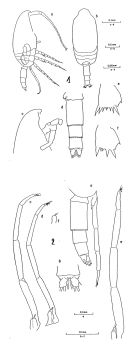 issued from : B. Frost & A. Fleminger in Bull. Scripps Inst. Oceanogr. Univ. California, San Diego, 1968, 12. [Pl.62, p.224-225; Pl.63, p.226-227]. Male: 1 a, habitus (right lateral view); 1 b, idem (dorsal view); 1 c, frontal region (right lateral); 1 d, urosome (armature of caudal rami incomplete); (dorsal view); 1 e, B2 of P2; 1 f, B2 of P3; 1 a-b b from same specimen; 1 c-d from different specimens; 1 e-f from another specimen; 2 a, Th.4-5 (posterior part) and urosome (right lateral view); 2 b, urosome 4 (posterior part), urosome 5, and caudal rami (armature incomplete) (dorsal view); 2 c-d, P5 (right lateral); 2 e, P5 (posterior); 2 f, right P5; 2 a-f taken from different specimens. Nota: Rostrum in lateral view knoblike and protruding ventrally. Prosome less than 6.45 times as long as urosomal segment 2. Caudal ramus less than 1.6 times as long as wide. P3 with basipodal 2 spiniform processes 2 and 3 not tapered uniformly from bas (see figure in Clausocalanus lividus Pl.1, c). Longer ramus of P5 and genital pore on left side. Left P5 longer than urosome.
|
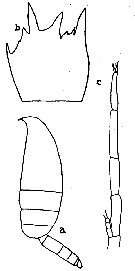 issued from : C.O. Esterly in Univ. Calif. Publs Zool., 1905, 2 (4). [p.143, Fig.13]; As Clausocalanus arcuicornis. With doubt. Male (from San Diego Region): a, habitus (lateral); b, 2nd basipodite segment of P3 (no P2 as in the figure)); c, P5. Nota: 2nd segment of abdomen at least as long as the 3rd and 4th together. Right P5 with 3 segments. Female with genital segment longer than the two following. Caudal rami as long as broad.
|
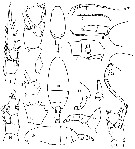 issued from : C.O. Esterly in Univ. Calif. Publs Zool., 1924, 26 (5). [p.89, Fig.C]. As Clausocalanus arcuicornis. Female (from San Francisco Bay); 5, distal portion of A1; 7, 1st and 2nd segments of abdomen, P5 (obliquely from right side); 8, 2nd basal and endopod of P2; 10, habitus (dorsal); 12, P5; 13, forehead and part of A1 (lateral; 14, P1; 15, 2nd basipodite segment of P2; 16, habitus (lateral); 17, urosome and last segment of thorax (lateral); 18, basipodites, endopodite, first two segments of exopodite of P3. Male: 1, P2; 2, 2nd basipodite, 1st and 2nd segments of endopodite and exopodite of P3; 3, habitus (dorsal); 4, A1; 6, urosome and posterior part of thorax (lateral), P5 longer one being the left; 9, right P5 (from right side); 11, forehead (lateral);
|
 issued from : B. Frost & A. Fleminger in Bull. Scripps Inst. Oceanogr. Univ. California, 1968, 12. [p.78, Table 4a]. Clausocalanus parapergens Females: Measurements and ratios . TL = total body length ; SL = spermatophore length ; P :U = ratio of prosome length to urosome length ; U :U1 = ratio of total urosome length to length of 1st urosomal segment (genital segment) ; S :U1 = ratio of spermatophore sac length to U1 length of female on which spermatophore is attached ; r = sample range; m = sample mean; n = number of specimens measured; s = sample standard deviation.
|
 issued from : B. Frost & A. Fleminger in Bull. Scripps Inst. Oceanogr. Univ. California, 1968, 12. [p.79, Table 4b]. Clausocalanus parapergens Males: Measurements and ratios . TL = total body length; P :U = ratio of prosome length to urosome length ; P:U2 = ratio of prosome length to length od 2nd urosomal segment; U2:2P5 = ratio of U2 length to length of 2nd segment of longer ramus of P5; U2:3P5 = ratio of U2 length of 3rd segment of longer ramus of P5; 3P5:2P5 = ratio of length of 3P5 of longer ramus to length of 2P5 of longer ramus; r = sample range; m = sample mean; n = number of specimens measured; s = sample standard deviation.
|
 issued from : B. Frost & A. Fleminger in Bull. Scripps Inst. Oceanogr. Univ. California, 1968, 12. [p.22, Fig.5]. Female caudal ramus length-to-width ratio (ordinate) plotted against caudal ramus length (abscissa) for Clausocalanus parapergens and C. brevipes.
|
 issued from : B. Frost & A. Fleminger in Bull. Scripps Inst. Oceanogr. Univ. California, 1968, 12. [p.20, Fig.2]. Ratio of length of A1 segment 2 to length of A1 segment 24 (ordinate) plotted against length of A1 segment 2 (abscissa) for females of C. parapergens, C. brevipes, and pergens.
|
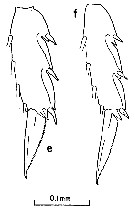 issued from : B. Frost & A. Fleminger in Bull. Scripps Inst. Oceanogr. Univ. California, 1968, 12. [p.223, Pl.61, e, f]. Female: e, exopodal segment 3 and terminal seta of P2; f, exopodal segment 3 and terminal seta of P4.
|
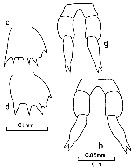 issued from : B. Frost & A. Fleminger in Bull. Scripps Inst. Oceanogr. Univ. California, 1968, 12. [p.223, Pl.61, c, d, g-h]. Female: c, basipodite 2 of P2; d, basipodite 2 of P3; g-h, P5 (from different specimens).
|
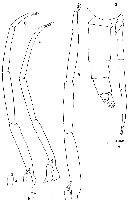 issued from : B. Frost & A. Fleminger in Bull. Scripps Inst. Oceanogr. Univ. California, 1968, 12. [p.227, Pl.63, a, c-e, f]. Male: a, posterior part of last thoracic segment and urosome (right lateral); c-d, P5 (right lateral); e, P5 (posterior); f, right P5.
|
 issued from : B. Frost & A. Fleminger in Bull. Scripps Inst. Oceanogr. Univ. California, 1968, 12. [p.225, Pl.62, e, f]. Male: e, basipodite 2 of P2; f, basipodite 2 of P3.
|
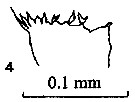 issued from : P.E. Lapernat & C. Razouls in Vie Milieu, 2002, 52 (1). [p.28, Pl. VI, fig.4]. Masticatory edge of Md gnathobase female (from off Malta, Mediterranean Sea). Nota: Itoh's index: 417.1 (number of teeth: 9).
|
 issued from : P.E. Lapernat & C. Razouls in Vie Milieu, 2002, 52 (1). [p.20, Pl. I, fig.6]. Masticatory edge of Md gnathobase female (from off Malta, Mediterranean Sea).
|
 Issued from : O. Tanaka in Spec. Publs. Seto mar. biol. Lab., 10, 1960 [Pl. XII, 6]. As Clausocalanus pergens. Male (from Indian Ocean): 6, forehead (lateral).
|
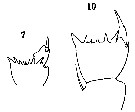 Issued from : O. Tanaka in Spec. Publs. Seto mar. biol. Lab., 10, 1960 [Pl. XII, 7, 10]. As Clausocalanus pergens. No confirmed by Frost & Fleminger. Female: 10, basis of P2. Male: 7, basis of P2.
| | | | | Compl. Ref.: | | | Park, 1970 (p.475); Björnberg, 1973 (p.313, 385); Peterson & Miller, 1976 (p.14, Table 1, 3, abundance vs interannual variations); 1977 (p.717, Table 1, seasonal occurrence); Carter, 1977 (1978) (p.35); Kovalev & Schmeleva, 1982 (p.83); Smith S.L., 1982 (p.1331, abundance, monsoon effect); Greze & al., 1983 (p.17, Rem.: p.24); Scotto di Carlo & al., 1984 (p.1041); Binet,1984 (tab.3); Regner, 1985 (p.11, Rem.: p.29); Greze & al., 1985 (p.7); Brinton & al., 1986 (p.228, Table 1); Madhupratap & Haridas, 1986 (p.105, tab.1); Pancucci-Papadopoulou & al., 1990 (p.199); Hirakawa & al., 1990 (tab.3); Scotto di Carlo & al., 1991 (p.270); Shih & Young, 1995 (p.72); Hure & Krsinic, 1998 (p.100); Suarez-Morales & Gasca, 1998 a (p109); Siokou-Frangou, 1999 (p.476); Lavaniegos & Gonzalez-Navarro, 1999 (p.239, Appx.1); Moraitou-Apostolopoulou & al., 2000 (tab.I); Lapernat & Razouls, 2001 (p.123, tab.1); Fragopoulu & al., 2001 (p.49, tab.1); Mackas & Galbraith, 2002 a (p.423, Table 2); Peterson & al. 2002, (p.381, Table 2, interannual abundance); Keister & Peterson, 2003 (p.341, Table 1, abundance, cluster species vs hydrological events); Vukanic, 2003 (139, tab.1); Hsiao & al., 2004 (p.325, tab.1); Peralba & Mazzocchi, 2004 (p.645, figs.3,6); Lo & al., 2004 (p.89, tab.1); Mackas & al., 2005 (p.1011, 1021, tab.2, 3); Mackas & al., 2006 (L22S07, Table 2); Isari & al., 2006 (p.241, tab.II); Zervoudaki & al., 2006 (p.149, Table I); Hooff & Peterson 2006 (p.2610); Khelifi-Touhami & al., 2007 (p.327, Table 1); Muelbert & al., 2008 (p.1662, Table 1, 3); Rossi, 2008 (p.90: Tableau XII); C.-Y. Lee & al., 2009 (p.151, Tab.2); Peterson, 2009 (p.73, Rem.: p 78); Galbraith, 2009 (pers. comm.); Chiba & al., 2009 (p.1846, Table 1, occurrence vs temperature change); Lan Y.-C. & al., 2009 (p.1, Table 2, % vs hydrogaphic conditions); Hernandez-Trujillo & al., 2010 (p.913, Table 2); Cornils & al., 2010 (p.2076, Table 3); Schnack-Schiel & al., 2010 (p.2064, Table 2: E Atlantic subtropical/tropical, Fig.4, 6, 7, Tabe 4); Mazzocchi & Di Capua, 2010 (p.425); Medellin-Mora & Navas S., 2010 (p.265, Tab. 2); Selifonova, 2011 a (p.77, Table 1, alien species in Black Sea); Mazzocchi & al., 2011 (p.1163, fig.6, long-term time-series 1984-2006); Isari & al., 2011 (p.51, Table 2, abundance vs distribution); Alves-da-Souza & al., 2011 (p.2125, Blastodinium infestation, Rem.: p.2129); Mazzocchi & al., 2012 (p.135, annual abundance 1984-2006); Shiganova & al., 2012 (p.61, Table 4); Jean & al., 2012 (p.12, Table 3, protein vs environmental metal stress); Takahashi M. & al., 2012 (p.393, Table 2, water type index); Gubanova & al., 2013 (in press, p.4, Table 2); in CalCOFI regional list (MDO, Nov. 2013; M. Ohman, comm. pers.); Lidvanov & al., 2013 (p.290, Table 2, % composition); Tachibana & al., 2013 (p.545, Table 1, seasonal change 2006-2008); Fernandez de Puelles & al., 2014 (p.82, Table 3, seasonal abundance); Mazzocchi & al., 2014 (p.64, Table 3, 4, 5, spatial & seasonal composition %); Zaafa & al., 2014 (p.67, Table I, occurrence); Benedetti & al., 2016 (p.159, Table I, fig.1, functional characters); Benedetti & al., 2018 (p.1, Fig.2: ecological functional group); Belmonte, 2018 (p.273, Table I: Italian zones); Palomares-Garcia & al., 2018 (p.178, Table 1: occurrence). Yebra & al., 2019 (p.1, Table 4: length, width) | | | | NZ: | 20 | | |
|
Distribution map of Clausocalanus parapergens by geographical zones
|
| | | | | | | | | | | | 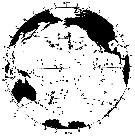 issued from : B. Frost & A. Fleminger in Bull. Scripps Inst. Oceanogr. Univ. California, San Diego, 1968, 12. [p.74, Chart 12, a]. issued from : B. Frost & A. Fleminger in Bull. Scripps Inst. Oceanogr. Univ. California, San Diego, 1968, 12. [p.74, Chart 12, a].
Occurrence of C. parpergens in samples examined; closed circles represent samples examined; open circles represent samples in which adults were found; bars through open circles represent samples from which specimens were removed for measurements. |
 issued from : B. Frost & A. Fleminger in Bull. Scripps Inst. Oceanogr. Univ. California, San Diego, 1968, 12. [p.75, Chart 12, b]. issued from : B. Frost & A. Fleminger in Bull. Scripps Inst. Oceanogr. Univ. California, San Diego, 1968, 12. [p.75, Chart 12, b].
Occurrence of C. parapergens in samples examined; closed circles represent samples examined; open circles represent samples in which adults were found; bars through open circles represent samples from which specimens were removed for measurements. |
| | | | Loc: | | | Cosmopolite (equatorial., subtropical.), sub-Antarct., South Africa, Angola, Uruguay (continental shelf), S Brazil, off S Cape Verde Is., Morocco-Mauritania, Caribbean Sea, Caribbean Colombia, G. of Mexico, Florida, W Ireland, Ibero-maroccan Bay, off W Tangier, Medit. (Alboran Sea, Baleares, Gulf of Annaba, Toulon Harbour, Ligurian Sea, Tyrrhenian Sea, G. of Naples, Strait of Messina, off Malta, Adriatic Sea, Ionian Sea, Aegean Sea, Thracian Sea, Lebanon Basin, Black Sea), Red Sea, South Africa (Natal), Somalia, Indian, Indonesia (SW Celebes), China Seas (East China Sea, South China Sea), Taiwan Strait, Taiwan (E, N: Mienhua Canyon, NW), Japan, Tokyo Bay, Pacif. (N-S), S Australia, New Caledonia, New Zealand, Vancouver Is., off Washington coast, Oregon (off Newport), California, Baja California (Bahia Magdalena), La Paz, G. of California, Chile (N & S) | | | | N: | 76 | | | | Lg.: | | | (30) F: 1,38-0,97; M: 1,15-0,97; (145) F: 1,38; M: 1,2; (340) F: 1,55; (787) F: 1,65-0,95; M: 1,092-1,0; (1225) F: 1,31; M: 1,10; {F: 0,95-1,65; M: 0,97-1,20}
The mean female size is 1.313 mm (n = 6; SD = 0.2926) and the mean male size is 1.103 mm (n = 4; SD = 0.0990). The size ratio (male : female) is about 0.87. | | | | Rem.: | epipelagic; sampling depth ( off Malta): 2000 m.
For Frost & Fleminger (1968, p.76) females are distingued from C. furcatus by the Prosome/Urosome and Urosome/Urosomal segment 1 length ratios, the relative lengths of Urosomal segments 1 and 3, and the appearance of the seminal receptacle in lateral view. Males differ from C. furcatus in the shape of the rostrum and the 3rd segment/ 2nd segment length ratio of P5. Males are distinguished with difficulty from C. mastigophorus and C. ingens; mastigophorus differs from parapergens in the Prosome/Urosomal segment 2 length ratio, while ingens differs only in the length-width ratio of the left segment 2 of P5. C. parapergens males are distinguished from lividus by the Urosomal segment 2/ 2nd segment of P5. Males of C. parapergens and laticeps differ in the form obf basipodal segment 2 spiniform processes 2 and 3 of P3. | | | Last update : 13/11/2020 | |
|
|
 Any use of this site for a publication will be mentioned with the following reference : Any use of this site for a publication will be mentioned with the following reference :
Razouls C., Desreumaux N., Kouwenberg J. and de Bovée F., 2005-2025. - Biodiversity of Marine Planktonic Copepods (morphology, geographical distribution and biological data). Sorbonne University, CNRS. Available at http://copepodes.obs-banyuls.fr/en [Accessed January 05, 2026] © copyright 2005-2025 Sorbonne University, CNRS
|
|
 |
 |



















